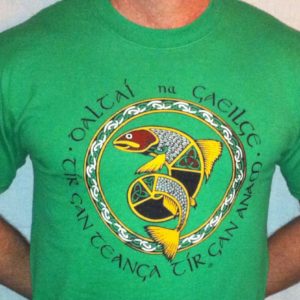Fáilte (Welcome) › Forums › General Discussion (Irish and English) › “táid siad”?
- This topic has 12 replies, 1 voice, and was last updated 11 years, 11 months ago by
Aislingeach.
-
AuthorPosts
-
May 8, 2012 at 12:27 am #36254
Aislingeach
ParticipantDo people actually say this? It seems kind of redundant. Or can you only use “táid” by itself as a response to a question?
GRMA
May 8, 2012 at 12:39 am #41827Cúnla
ParticipantYeah, “táid siad” exists despite being ‘redundant’ relative to the rest of the Irish verbal-pronominal agreement system…
May 8, 2012 at 1:36 am #41828Wee_Falorie_Man
ParticipantMy friend from Múscraí tells me that táid siad does exist but he prefers táid. And you can use it at other times -not just when you’re answering a question.
Conas táid? – How are they?
Cad é an saghas prátaí atá agaibh? Táid mion, fliuch, fánach, criochánach, piastach.
May 9, 2012 at 1:07 am #41833Aislingeach
ParticipantGo raibh maith agaibh. I don’t believe I have ever seen a synthetic form used with a pronoun in anything I’ve read. Is this specific to “tá”? Or am I apt to see more of it when I start really studying verbs?
GRMA
May 9, 2012 at 2:31 am #41834Wee_Falorie_Man
ParticipantI don’t believe I have ever seen a synthetic form used with a pronoun in anything I’ve read.
Well, now that you mention it, I don’t think I’ve ever seen it either. Of course, that doesn’t mean that it doesn’t exist – I’ve only recently started reading actual books so I’m probably the wrong person to be commenting on this sort of thing. But if I ever happen to run across it I’ll let ya know.
May 9, 2012 at 8:49 am #41835An Lon Dubh
ParticipantIn some older books you’ll see the verb agree with the number of subjects like:
Táid an cat agus an gadhar ag rith tímpeall na páirce.
May 9, 2012 at 4:03 pm #41838Cúnla
Participant“Bhíodar beirt i láthair ann…”
May 9, 2012 at 5:32 pm #41839Lughaidh
ParticipantIn this sentence I would understand “beirt” as a kind of adverb.
If it were the subject it would be preceded by the article: Bhì an bheirt (acu) ann.May 10, 2012 at 12:10 am #41841Aislingeach
ParticipantGo raibh maith agaibh, arís
A WFM, I’ve not read extensively either, but that just stuck out like a sore thumb to me, so I’m thinking I would have remembered had i seen it before. I did find something on http://www.nualeargais.ie/gnag/gram.htm
According to that, with regard to the synthetic forms (in relevant part)
“no personal pronouns are allowed*
* after the 3rd person pl., there is an exception to the rule and a pronoun or a noun is allowed (whereby this form is also is used analytically)”
I wonder why that is…….
May 10, 2012 at 12:55 am #41842Wee_Falorie_Man
ParticipantA Aislingeach,
I’m sure the “Gramadach na Gaolainne” site is correct; it is by far, the best Irish grammar “book” that I have ever run across.
I think I’ve seen bíd siad somewhere before, but I didn’t want to say anything because I wasn’t sure. I was once told that the synthetic forms are much older than the analytic forms, and things like táid siad and bíd siad are also very old. I haven’t researched it, but it sounded true to me.
May 10, 2012 at 11:40 pm #41847Aislingeach
ParticipantOh, I have no doubt that it’s correct, but that just makes me all the more curious. Why only the third person plural? The more I learn the deeper it sucks me in! It wouldn’t surprise me a bit if two years from now I was reading everything I could find on Middle and Old Irish. I bet it would answer many of my questions. I wonder if there are any books that cover the various grammar changes from Old Irish to the present. That would be a very interesting read.
May 11, 2012 at 12:15 am #41848Lughaidh
ParticipantI guess ‘Stair na Gaeilge’ would help you, if you can read “scientific” Irish…
May 12, 2012 at 10:45 am #41861Aislingeach
ParticipantYes, from what I could Google, that seems to be the type of book I had in mind. But, if by “scientific” you mean full of technical, linguistic words and terms, no, I wouldn’t be able to read it yet. But I’ll add it to my list. GRMA as an eolas.
-
AuthorPosts
- You must be logged in to reply to this topic.
